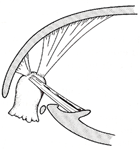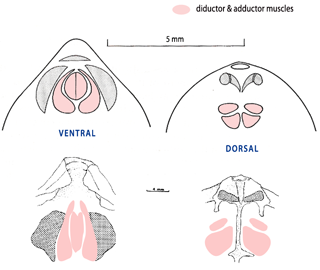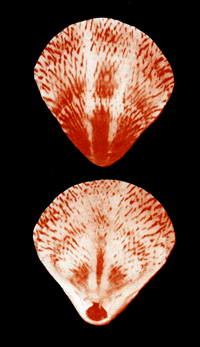|
Calloria inconspicua (Sowerby, 1846)
Type locality: "From the late G. Humphrey's collection: locality unknown" (Sowerby, 1846).
Depth range: 0 - 92 m > 184 m
Terebratula inconspicua Sowerby, 1846 p. 93; 1847.
Terebratella inconspicua: Thomson (1927)
Terebratula rubicunda Sowerby, 1846, p. 92
Diagnosis - Sowerby (1846), see also Sowerby (1847)
Ter. testâ rotundato-subtrigonali, postice acuminato-rotundatâ, antice subsinuatâ, obscure rufâ; valvis inæqualibus,glabris; lineâ marginali flexuosâ; valvâ dorsali rotundato-subtrigonâ, maximâ incompletâ; areâ cardinali latâ, ad utrumque latus declivi; deltidiis mediocribus, latè discretis; valvâ ventrali transversim oblongâ, subplanulatâ, sulco mediano, lato, subinconspicuo; margine valvarum integro.
Shell rounded, subtrigonal, acuminated and rounded behind, slightly sinuated before, dull red; valves unequal, smooth; marginal line flexuous; perforation large, incomplete ; cardinal area broad, inclining on each side; deltidia of moderate size, widely separated; ventral valve transversely oblong, somewhat flattened, with a broad, rather indistinct mesial groove ; margin of the valves entire.
Should be added:
Pedicle characteristics: short and stout, sheath of thin, flexible chitin.
Muscle disposition: see Fig. in front
|

Disposition of the pedicle and pedicles muscles - sagittal section
(from Richardson, 1979)

Muscle attachment (modified, from Richardson, 1979; and
from Foster, 1974 - with absence of separate posterior accessory diductor muscles base, the pair of ventral adductor muscle bases in a single unit, and dorsal, and the dorsal pedicle adjustor muscle bases not located at the anterior edge of the hinge plate)
|
|
Calloria variegata Cooper et Doherty, 1993.
Type locality: Te Hue Point, Little Barrier Island, North Island, New Zealand
Depth range: 10 - 30 m.
Terebratella sp. cf. Magella carinata: Thomson (1915, p 409)
Terebratella sp.: Brook (1980)
Terebratella sp.: Dawson (1992)
Diagnosis - Cooper & Doherty (1993)
Medium size, up to 23 mm in length; outline subpentagonal; length and width nearly equal;
maximum width at or slightly anterior to midvalve. Ventral valve deeper than dorsal valve.
Sides narrowly rounded; anterior margin rounded, post-lateral margins straight, forming
angle in adults ranging from 65° to 85°. Beak suberect, truncated; foramen large,
submesothyridid; deltidial plates disjunct in young, either disjunct or conjunct in adults.
Pedicle short, distally frayed. Lateral commissure slightly sigmoidal; anterior commissure
unisulcate. Surface smooth, except for anterior costation in some old adults. Colour solid red
in very young ventral valve, cream colour with red straight or cuneiform dashes arranged in
three longitudinal bands, two lateral, one medial in adult. Punctae 192/mm2.
Ventral valve interior with short sessile pedicle collar and lightly impressed muscle field.
Dorsal valve interior having well defined septal plates that meet grooved median septum.
Adult loop terebratellid, occupying 70% of valve length and 40% of valve width. Pallial
canal system ventral valve pinnate, dorsal valve pinnate (apocopate). Lophophore plectolophus.
|

From Cooper & Doherty (1993)
|




